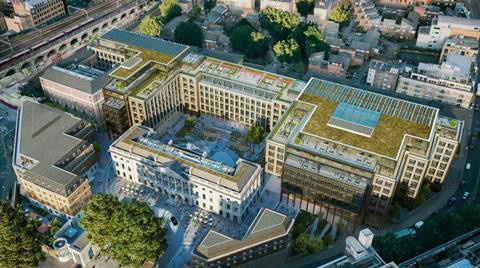Force had opposed David Chipperfield-designed plan to redevelop former Royal Mint site as late as last month
The Metropolitan Police has withdrawn its objection to plans to build a new Chinese embassy in London after seeing research first submitted to the local council three years ago.
Scotland Yard had objected to the David Chipperfield-designed scheme at the former Royal Mint site, next to the Tower of London, as recently as last month over fears that there would not be enough space in front of the proposed embassy to safely accommodate more than 100 protestors.

It has now decided to back the scheme after being provided with “additional information” in the form of a 10-page report titled “pedestrian comfort level assessment” drawn up for the Chinese government by Arup and Cundall.
But this report was submitted in February 2022 to a previous and largely identical version of the scheme, to which the Met was a key consultee.
It claims that up to 4,500 people could fit safely on the streets surrounding the proposed embassy, and up to 1,920 could be accommodated on space immediately in front of the site.
The former application was rejected by the council in 2022 partly because of concerns over large numbers of protestors which could congregate at the site.
The proposals were resubmitted in July last year but called in by communities secretary Angela Rayner in October. A public inquiry at the Planning Inspectorate is scheduled to start on 11 February and sit for up to six days, according to an update submitted to the council on Friday.
Both Tower Hamlets council and the Met had objected to the scheme at a meeting of the council’s strategic development committee on 9 December last year, at which councillors had voted to nominally reject the application.
Tower Hamlets has now also withdrawn its objection to the plans following the withdrawal of the Met’s objection, which had been the basis for the council’s opposition.
The Met’s move follows a letter sent to the council earlier this month on 14 January by foreign secretary David Lammy and home secretary Yvette Cooper referencing “further technical detail” which had been provided by Tower Hamlets following a meeting on 12 December last year.
Lammy and Cooper said: “Whilst there remain differences of opinion on where protesters would most likely congregate, on balance, the Metropolitan Police’s public order experts are content that there is sufficient space for future protests without significantly impacting the adjacent road network.
“The Metropolitan Police have therefore withdrawn their objection to the application.”
This was followed by an update to the council three days later from Scotland Yard Deputy Senior National Co-ordinator Elisabeth Chapple using similar wording as Lammy and Cooper to describe the Met’s position.
Chapple added: “Were the information to have been made available to the MPS in advance of the Tower Hamlets Strategic Development [Planning] Committee, the MPS would not have objected to the application, and in light of the additional information the MPS has accordingly removed its objection to the application progressing.”
A spokesperson for the Met Police said: “In December we objected to this application due to the potential impact of protests on local roads. The borough council has since re-introduced an assessment of the surrounding area’s ability to accommodate protests – this was not available at the point our objection was made.
“We have now considered this assessment and are satisfied the road network should not be significantly affected. As a result, we have removed our objection and expect that the planning inspector will provide their recommendation to the Government.”
In its previous objection to the plans, the Met had warned of “serious disruption” to the local area which could be caused by protests outside the embassy.
In a letter on 14 November last year, the force’s deputy assistant commissioner Jon Savell said “there is nowhere at the location that would accommodate more than approximately 100 protestors”.
He added: “In the event that more than 100 protestors attend the location they will either spill into the road or have to move across towards the Tower of London, an obvious iconic tourist attraction, which would adversely impact on visitors and other users of the area.”
Savell said overspill of protestors would compromise surrounding roads, which would be difficult for the police to ensure the safety of protestors without shutting down roads and causing greater community and business disruption.
He added that the impact on local policing would be “significant” and would require officers to be “taken away from frontline duties to fulfil the requirement of policing spontaneous and known protests at this location”.
Savell’s letter also noted that the new 2024 application “appears to have been made with no changes from the initial proposal and with no consideration for the issues that led to its rejection previously”.
The Met’s decision came days after chancellor Rachel Reeves returned from a trip to Beijing in an effort to improve trade and diplomatic relations with China, the world’s second largest economy.




























No comments yet